|
|
|
Sort Order |
|
|
|
Items / Page
|
|
|
|
|
|
|
| Srl | Item |
| 1 |
ID:
131467
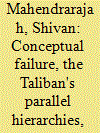

|
|
|
|
|
| Publication |
2014.
|
| Summary/Abstract |
ISAF exists to protect the Afghan constitutional model. This strategic objective will be defeated because the GIRoA model has a conceptual flaw that renders it incapable of delivering governance at the local level (Tier IV). This fatal flaw has enabled the Taliban, by developing parallel hierarchies, to displace GIRoA and establish itself in southern locales as the political authority. The Taliban are fighting a revolutionary war, a Maoist displacement strategy that uses guerrilla tactics to advance a political program. Petraeus and McChrystal failed to recognize the character of war, and believed the Taliban are pursuing an exhaustion strategy. They failed to devise a counter-RW strategy. The 'Surge' was doomed ab initio
|
|
|
|
|
|
|
|
|
|
|
|
|
|
|
|
| 2 |
ID:
131466
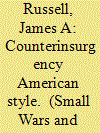

|
|
|
|
|
| Publication |
2014.
|
| Summary/Abstract |
This article examines the complex legacy of David Petraeus who was a key figure in the emergence of the US military shift towards counterinsurgency doctrine in the years after 2006. Although Petraeus has been perceived by critics as a publicity seeker, he can be credited with laying the foundations for a more serious commitment to COIN involving in particular in integrating conventional and Special Forces in arenas like village stability operations. The article looks a Petraeus's role in both Iraq and Afghanistan: it concludes that, in the case of Afghanistan, it is too early to assess whether counterinsurgency has had a decisive impact of the outcome of the war against the Taliban.
|
|
|
|
|
|
|
|
|
|
|
|
|
|
|
|
| 3 |
ID:
131470
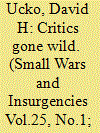

|
|
|
|
|
| Publication |
2014.
|
| Summary/Abstract |
The Western interventions in Iraq and Afghanistan have produced a heated polemic concerning the merits and demerits of counterinsurgency - the operational approach underpinning both campaigns. The two books reviewed here provide a good summation of the arguments against counterinsurgency: it is not a strategy and will fail when mistaken as such; its theory does not make intervention and war significantly easier; and even the most successful counterinsurgency campaigns have been bloody, violent, and protracted. Yet as this review highlights, beyond these central points, criticism of counterinsurgency is too often off the mark in its approach and totalizing in its pretentions. There is much to criticize and an urgent need to learn from past campaigns, yet bold claims and broad generalizations can mislead rather than enlighten. The analysis is particularly unhelpful when the definition of the central issue at hand - counterinsurgency - is being unwittingly or deliberately distorted. In the end, these two books form a poor basis for the debate that must now take place, because they are too ideological in tone, too undisciplined in approach, and therefore too unqualified in what they finally say.
|
|
|
|
|
|
|
|
|
|
|
|
|
|
|
|
| 4 |
ID:
131472
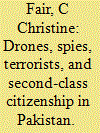

|
|
|
|
|
| Publication |
2014.
|
| Summary/Abstract |
This essay reviews seven recent books and reports that focus upon the use of US armed drones in Pakistan's Federally Administered Tribal Areas (FATA). This essay synthesizes a historical account of the program, critically interrogates key arguments and evidence advanced by the authors, and draws attention the particular problems that confront those who live in the FATA and the second-class citizenship that the Pakistani state has bestowed upon them for reasons of domestic and foreign policy concerns. This review essay does not intend to be the final word on any of the ongoing policy debates. But it does hope to enable a wider audience to take part in these important deliberations.
|
|
|
|
|
|
|
|
|
|
|
|
|
|
|
|
| 5 |
ID:
131471
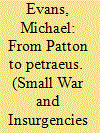

|
|
|
|
|
| Publication |
2014.
|
| Summary/Abstract |
War is the great auditor of military institutions and since the attacks of 9/11, the United States military has been under audit for well over a decade - the longest period of continuous warfare in its entire history - and one in which strategic success seems at best, ambiguous and at worst, elusive. Not surprisingly, the strategic skill and battlefield effectiveness of the American military has been a subject of great inquiry over the last five years. Thomas E. Ricks's mammoth study, The Generals: American Military Command from World War II to Today is but the largest instalment in a plethora of works examining America's military performance in the modern era by such writers as David Cloud and Greg Jaffe, Stephen R. Taaffe, Lewis Sorley, Jean Edward Smith, and Fred Kaplan.1
|
|
|
|
|
|
|
|
|
|
|
|
|
|
|
|
| 6 |
ID:
131465
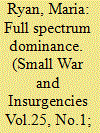

|
|
|
|
|
| Publication |
2014.
|
| Summary/Abstract |
This article examines the evolution of US irregular warfare (IW) doctrine and practice from 2001 onwards. It argues that, after 9/11, top-tier civilian policymakers in the US Department of Defense (DoD) and across the US government developed a heightened awareness of asymmetric threats and non-conventional forms of warfare, especially those shaped by contemporary globalisation. The result was a gradual turn towards irregular warfare, led by Rumsfeld and the DoD, designed to ensure 'full spectrum dominance' across all modes of conflict. This pre-dated the insurgency in Iraq and the promotion of counterinsurgency in the US Army by General David Petraeus and others. Policymakers' reluctance to acknowledge the insurgency in Iraq was not down to a failure to understand the concept of IW, but because they had viewed Iraq in conventional terms for so many years and were reluctant to admit their mistake.
|
|
|
|
|
|
|
|
|
|
|
|
|
|
|
|
| 7 |
ID:
131464
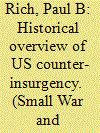

|
|
|
|
|
| Publication |
2014.
|
| Summary/Abstract |
This introductory article introduces some of the articles in this issue and examines the debate surrounding the idea of the "COINdinistas" in the US. It traces the roots of their approach to counter-insurgency and distinguishes "small c" counterinsurgency based on small groups of military advisers in "peripheral" conflicts from "big C" counter-insurgency which became allied to modernisation theory and nation building. The article also looks at developments in COIN thinking after the drawdown of US and other ISAF forces from Afghanistan, especially the work of David Kilcullen focussed on the emergence of future mega "feral" cities on coast lines vulnerable to terrorist and insurgent attacks
|
|
|
|
|
|
|
|
|
|
|
|
|
|
|
|
| 8 |
ID:
131474


|
|
|
|
|
| Publication |
2014.
|
| Summary/Abstract |
This article explores the historical reasoning behind counterinsurgency thinking, particularly as applied to Iraq, using Douglas Porch's book, Counterinsurgency: Exposing the Myths of the New Way of War as a reference point. It argues that the classic historical analogies of counterinsurgency theory were inapt in dealing with the conflict in Iraq, and that the historical reasoning behind counterinsurgency more generally deserves greater scrutiny. Not only are the analogies of questionable applicability, but the evidence of causation in prior conflicts is ultimately unproveable. In the end, Counterinsurgency theory and the US Army's Field Manual 3-24 on Counterinsurgency were politically useful during the 'Surge', beginning in 2007, but remain intellectually and historically problematic.
|
|
|
|
|
|
|
|
|
|
|
|
|
|
|
|
| 9 |
ID:
131468
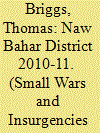

|
|
|
|
|
| Publication |
2014.
|
| Summary/Abstract |
This article provides a critical analysis of counterinsurgency in Afghanistan at the tactical level. The efforts of several Naval Special Warfare detachments deployed to Naw Bahar district in Zabul Province, Afghanistan are examined in detail to identify key successes and failures in planning and execution. It defines the operating environment in which the detachments worked and identifies the goals and outcomes of the first and second phases of the counterinsurgency effort. The article concludes by placing the tactical effort in the context of the overall strategy in Afghanistan and suggests that time is the limiting factor to success.
|
|
|
|
|
|
|
|
|
|
|
|
|
|
|
|
| 10 |
ID:
131473
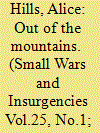

|
|
|
|
|
| Publication |
2014.
|
| Summary/Abstract |
Afghanistan has been the defining experience of conflict for many Western militaries, so it comes as no surprise that Out of the Mountains begins with an account of the author watching a patrol fight its way out of an ambush in a remote valley in Afghanistan. But, rather than projecting this experience as the future course of conflict, David Kilcullen argues that wars in mountainous, landlocked places such as Afghanistan will become increasingly rare. In the future, most conflicts will take place in the urban littoral because that is where most people live.
|
|
|
|
|
|
|
|
|
|
|
|
|
|
|
|
|
|
|
|
|